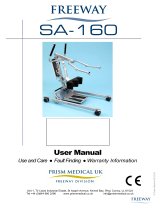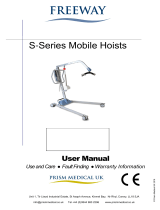Page is loading ...

User Instructions
Deep Back Support Sling
Range
Lightweight
General Safety Warning
Please ensure these instructions
are fully read and implemented.
Failure to do so may result in
injury to the user. Retain in a safe
place for future reference.
In the interest of safety;
Persons using this equipment
should have received appropriate
training or instruction.
Hoisting transfers should only be
attempted following a
comprehensive risk assessment
and should be performed in
accordance with local Moving &
Handling Guidelines.
Intended Use
The Deep Back Support Sling range
is designed to suit a wide range of
users and transfer needs, including
bathing. They can be used on hoists
fitted with a conventional spreader
bar (i.e. with hooks at either end from
which looped straps may be
suspended)
If you are unsure about compatibility
with the spreader bar contact NRS
customer services, contact details
overleaf.
Sling Guide
Size/Colour Code Ex. Small Small
Medium Med/large Large
Sling Code
M07335
M07347
M07359
M07360
M07372
Client
Measurements
Head to Sacrum
500 -
600 mm
19½”-
23½”
600 -
850 mm
23½”-
33½”
850 -
1050 mm
33½”-41”
930 -
1130 mm
36½”-
44½”
1050 -
1200 mm
41”-47”
Maximum User Weight
27
1
/
2
st
175kg
UI/M07335/ M07347/ M07359/ M07360/ M07372/1111/Issue7
Nottingham Rehab Supplies
Clinitron House, Excelsior Road,
Ashby Park, Ashby de la Zouch,
Leicestershire, LE65 1JG
United Kingdom
Tel: 0845 120 4522
Int’l: +44 (0) 1530 418378
Fax: 0845 121 8112
Email:
customerserv[email protected]k
www.nrs-uk.co.uk
Fitting and Operational
Instructions – continued;
6 - Attach the shoulder straps to the
hoist spreader bar. (The middle loop
on each shoulder strap will give a
reasonably upright sitting position.)
A more reclined position can be
achieved by using a longer loop. For
a more upright posture choose a
loop closer to the sling.
7 – Attach the head support panel
straps to the spreader bar, this must
be done after the shoulder straps
have been fitted. To achieve a
comfortable position in which the
client’s head is correctly supported
the straps can be adjusted by
opening the cam buckle on the
strap, pulling the strap through until
the correct length is achieved; the
cam buckle should then be closed
securely. Note: Inspect the cam
buckles, regularly, for signs of wear
or damage.
8 - Attach the leg straps to the hoist
spreader bar. The middle loop on
each leg strap will give a reasonably
natural sitting position. The client’s
knees can be raised by selecting a
loop closer to the Sling.
9 - Ensure that all loops are fully
attached to the spreader bar, and
that the sling is well positioned and
not attached in any way to the seat
or other obstacle.
10 - Ensure client is secure and
comfortable.
11 - Before commencing the hoist,
carers must be in the pool to ensure
that the transfer into the water is
achieved safely and that all normal
safety considerations are observed.
12 - Raise the hoist spreader bar to
lift the client just off the surface.
Check that all loops are connected
and the client is secure and
comfortable prior to completing the
transfer.
WARNING: Do not attempt to adjust
or detach any strap while the client
is being hoisted.
Carers must support the client whilst
straps are detached. Note the Head
support straps must be detached
before the shoulder straps.
Fitting from the Lying position
Roll the client onto the sling,
ensuring that the Bottom edge of
the Head Support panel is level with
the base of the neck, and the
bottom edge is positioned just below
the coccyx. Follow instructions from
point 3 of the seated position
instructions.

CAREFULLY EXAMINE
ALL STITCHING
Fitting and Operational
Instructions
Before every lift, visually inspect
the sling to ensure it is fit for
purpose. Refer to the Inspection
Routine section of this guide for
the recommended method. If in
doubt do not use the sling.
In the interest of safety;
Persons using this equipment
should have received appropriate
training or instruction.
Hoisting transfers should only be
attempted following a
comprehensive risk assessment
and should be performed in
accordance with local Moving &
Handling Guidelines.
Fitting from the seated position
1 - Place the Sling behind the client
with the bottom edge of the head
support panel level with the base of
the client’s neck.
2 - Position the sling by pulling the
bottom edge briskly from left to right
and back again, the bottom edge of
the Sling can be positioned 25-50 mm
under the client’s buttocks.
3 - Pull the leg straps forward parallel
with the client’s upper leg. (It may be
helpful to “block” the client’s knee
with one hand while this is being
done).
4 - Pull each leg strap under the
adjacent upper leg, so that both
straps emerge between the client’s
legs.
5 - Each leg strap should now be
positioned comfortably under the
client’s leg. If not, go back to step 3
and repeat.
CHECK:
• All Stitching MUST be intact.
• There should be no
Material Degradation
around stitching.
Cleaning Instructions:
Note: The head support stiffening
bars (Positioned in the head support
section of the sling) MUST be
removed before the sling is washed.
• Machine wash warm at up to 70ºC
• For effective decontamination,
wash at greater than 65ºC for at
least 10 minutes
• Do not use bleach, biological
detergents or detergents
containing bleach.
• Do not spot clean with strong
chemicals
• Do not iron.
• Do not dry clean
• Tumble dry only on ‘cool’ setting
or air dry at very low
temperatures.
Inspection Information
The following notes are a guide to the
recommended inspection procedures
for slings.
If carried out thoroughly, at regular
intervals, lifting and hoisting
operations can be carried out with
confidence, and the risk of injury due
to sling failure is significantly reduced.
Before every lift, visually inspect the
slings structural integrity. Use the
diagrams as a guide. If there are any
signs of damaged fabric or stitching
do not use.
If you are unsure, do not use the sling,
withdraw from service immediately.
The product should then be either
discarded, or clearly labelled:
“Not for use” and assessed at the
earliest opportunity by a competent
individual.
A visible nick – even of
only 1mm SHOULD BE
DEEMED UNSAFE
STRAPPING INSPECTION
Sl
ing Inspection procedure;
The following procedure is
recommended to help ensure that
lifting and hoisting operations can
be carried out with confidence and
the risk of accident due to sling
failure is minimised.
• Open the sling out fully on a
flat surface.
• Check all retaining straps for
cuts, nicks or degradation of
any kind.
• Carefully check all stitching.
• Check the material near to any
attachment points.
• Pay particular attention to the
areas of high stress as shown
in diagrams.
• Checks should be carried out
to both sides of the sling in the
same manner.
• Discolouration may also
indicate fabric degradation.
Areas of High
Stress
A few loose strands are
ACCEPTABLE
/













